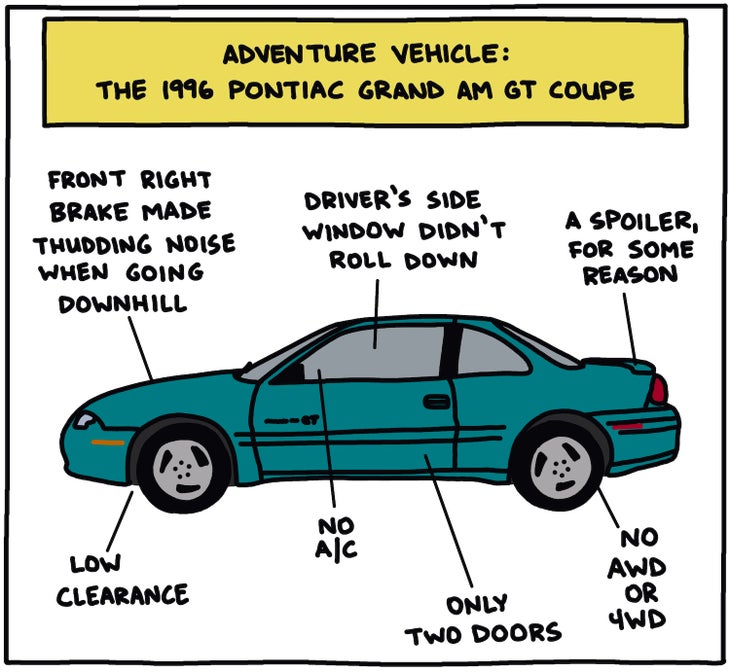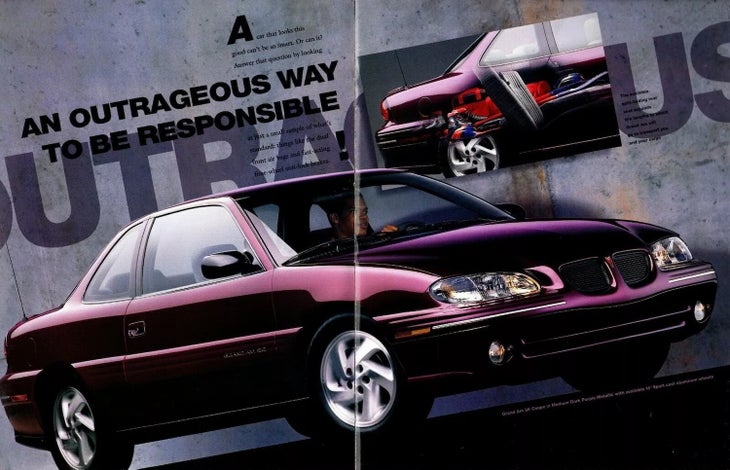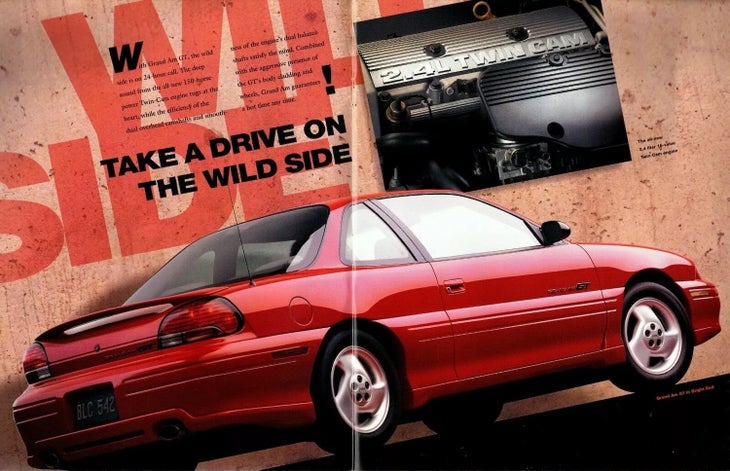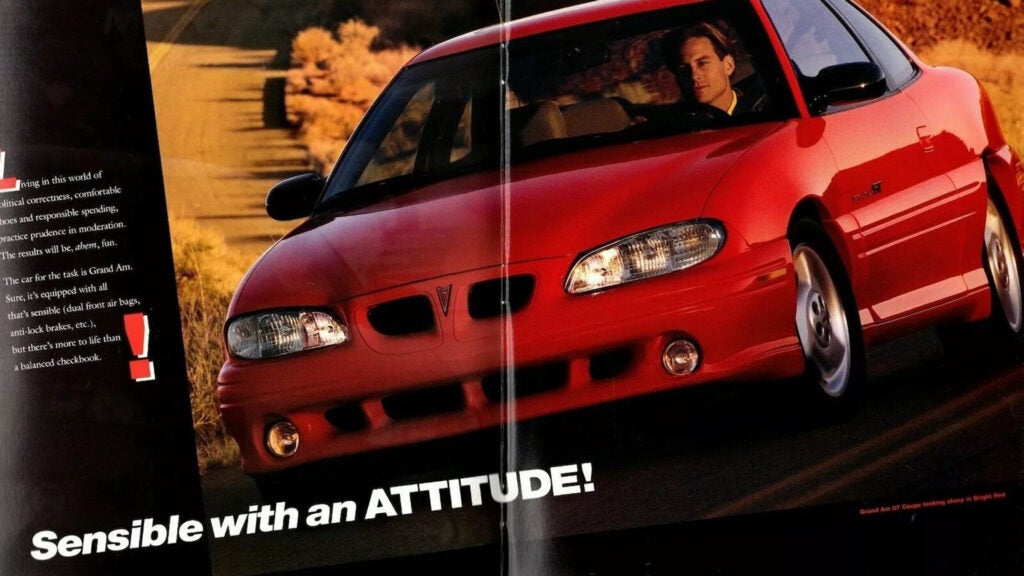No products in the cart.
Outdoor Adventure
An Ode to the Worst Adventure Car—and All the Places It Took Me
I think of my old car sometimes when I drive by the Walmart Supercenter. The parking lot there was essentially the launch point of my first real long-distance road trip as an adult, spanning ten days and eight states in the late spring of 2004. We drove my 1996 Pontiac Grand Am GT, a car that my friend Nick announced had taught him that he would “never buy a two-door car.”
I didn’t keep a journal of the trip, but I believe Nick said that while standing in the Watchman Campground in Zion National Park, on maybe our eighth day of wrangling gear in and out of the car’s back seats. We couldn’t use the trunk because it was full of everything I could justify bringing from my grad school apartment in Missoula, Montana, to our terminus in Scottsdale, Arizona, where I was moving in with my then-girlfriend. We tried to keep what we needed in the backseat, and of course to access anything in the backseat, you had to fold the front seat down, lean in, and bend around the corner.
I believe this type of two-door design was, and maybe still is, referred to as a “coupe,” a word that is almost never paired with the word “adventure,” which is what we were trying to use the Grand Am for, and certainly not the word “dirtbag,” which is the type of adventure we were trying to have.
We left Missoula about 10 days before Memorial Day. Nick bussed in via a Greyhound from somewhere in Iowa, an 18-hour ride he’d probably never do again. So a car, any car, a space he’d only have to share with one person, probably felt like an improvement.
I had gotten the car through my college roommate Chris, whose brother, Andy, had bought it at an auction, repaired the one thing that was wrong with it (someone had tried to steal the passenger-side airbag), and then sold it to me. There were a few reasons why it was not the ideal road trip car, some of which were my fault.

I had packed the trunk almost full by the time Nick added his stuff, and then attached a trunk-mount Yakima bike rack to haul an old Schwinn mountain bike all the way to Arizona, so if either of us wanted anything in the trunk, we had to remove the bike, pull off the bike rack, and then open the trunk. The bike and the rack, of course, fell off the back of the car multiple times on bumpy mountain roads, first on our way up and down to the Mt. Pilchuk trailhead outside of Seattle. The summit was in a cloud when we arrived at the end of our short, steep hike.
People sleep in all kinds of adventure vehicles—old vans, new Sprinter vans, RVs, trucks with toppers, trucks with campers, station wagons, even in sedans in which the back seats fold down. The Grand Am’s seats did not fold down. And we couldn’t recline the front seats very far on account of all our stuff in the backseat. Still, we slept in the car twice, because we were young and durable, and had no other options, once next to the ocean somewhere near Aberdeen, Washington, and once near Barstow, California, where we’d driven after hiking up Half Dome and being unable to find a campsite anywhere near the park.
We camped almost all the other nights, except for a couple nights we spent on friends’ floors in Seattle and Bend. The trunk light somehow melted a hole in Nick’s Therm-a-Rest on the second-to-last day of the trip, so he slept rather uncomfortably on our last night in Mexican Hat, Utah. We’d walked into the ranger station at Natural Bridges National Monument late that afternoon and asked about campsites, and in an I-swear-this-actually-happened exchange that I’ve written about elsewhere—it’s so dumb it sounds like I made it up—the ranger said, “You guys don’t want to camp here. You’ll be done with this park in an hour. Tell you what: Are you intense?”
I looked at Nick, kind of shrugged, and nodded. We were young, fairly fit, and maybe looked pretty intense, I guess. The ranger went on to tell us to head south to Valley of the Gods, the entirety of which was BLM land, and we could just pull off the road and camp anywhere we found a spot. We thanked him for the advice and left, and I was unlocking the car door in the parking lot by the time I realized what he’d actually said. Over the roof of the car, I said to Nick,
“Oh, he meant ‘in tents,’ like are we camping in tents or do we have an RV.”
“Yeah,” Nick said, not understanding my confusion.
The low clearance of the Grand Am meant we didn’t get too far into Valley of the Gods before we chickened out and drove back to the paved highway, and spent the night in a paid campground behind a lodge in Mexican Hat. It was not that intense. The next day we drove through Monument Valley, checked out the South Rim of the Grand Canyon, and gave the car a well-earned rest in a visitor parking spot at my girlfriend’s apartment complex in Scottsdale, after the biggest adventure it would ever go on.
To be fair, I had not bought the car under any pretense of it being a “road trip vehicle” or “adventure vehicle.” I bought it because it was a pretty good deal, from a trusted friend, and I was not very picky about cars. And I didn’t treat it that well—I bought it in 1999, if memory serves, and I have been sober since March 2002, but the period of time between was a bit rough on the car. The inoperable driver’s-side window was my fault (rolling it down when it was iced over), as was whatever went wrong with the front right wheel (hit a curb at high velocity). The windshield had been shattered once (a friend tried to jump over the car as we were leaving a party; I eventually got it repaired), and the trunk-mount CD player had been smashed by a full beer keg that rolled into it (on the drive back to our party).

Still, it was what I had, and entering the job market in 2004 with a graduate degree in journalism, I wasn’t exactly ready for a down payment on a new BMW. Or any car, really. I worked for a year in the Phoenix area, and then moved to Denver, where the Grand Am was even less useful, because, you know, snow.
Luckily, Nick, who lived in Denver, had bought a 2004 Toyota Tacoma, and was willing to drive to Summit County ski resorts in the winter and mountain trailheads all summer. One winter day, though, I drove up to Rocky Mountain National Park to snowshoe, and met a guy my age who also happened to be from the Midwest. We chatted all the way back to the parking lot, and when I stopped behind the Grand Am, he asked, “Is this your car?”
I said, “Yeah. It’s kind of a Midwest car.”
He said, “It’s kind of a meth car.”
I wasn’t about to defend the Grand Am’s honor. I mean, its overall aesthetic didn’t exactly scream “NOT a meth car,” but it also had never really let me down, at least not in a big way. And although we never drove my car to a trailhead if there was any sort of questionable dirt road involved, I thought of the day the previous summer that we had taken Nick’s Tacoma to climb Grays and Torreys peaks. The road to the trailhead was rough with bumps, holes, and big exposed rocks, and I was glad Nick had volunteered to drive his truck.
But then, about a half-mile from the trailhead, the Jeep in front of us slowed, and in front of the Jeep was someone in a Honda Civic negotiating a very tricky-for-a-sedan spot in the road, backing up, re-orienting, pulling forward, backing up again, and then sending it, with nary a scrape. The Civic made it to the trailhead just fine. I lived in Colorado off and on for 15 years, and I learned that whenever you think that a Forest Service road is impassable by anyone without high clearance and 4-wheel-drive, you’ll always see that someone made it up to the parking area in a goddamn Honda Civic.

The Grand Am survived our 10-day, eight-state road trip, and saw its share of national parks and quite a few Forest Service roads, but it was never my first choice if anyone else was willing to drive their vehicle for a day of hiking or skiing. One night in February 2006, I was cruising up Josephine Street in Denver with my then-girlfriend, and a guy floored it from a stop sign on 5th Avenue, not seeing us until his car bulldozed into the front passenger side of the Grand Am at full speed. We rammed into a light pole on the street corner, hard enough to bend it, but not hard enough to knock it over. Just after we came to a stop, I looked over to my girlfriend and asked, “Are you OK?” She answered yes, she thought she was OK. A few seconds later, I quietly but excitedly said, “I think the car’s totaled.” The car’s destruction, of course, being the only way I would be able to replace it, with my $25,000/year salary at the newspaper. As soon as the insurance money came, I found an all-wheel-drive 1996 Subaru Impreza Outback on Craigslist. I figured it could take me anywhere I wanted to go, and it did.
The Grand Am was a bad fit for the lifestyle I wanted at the time—I was chomping at the bit to see the world, and the world I wanted to see didn’t have smooth roads leading to it. It was a piece of gear that didn’t work that well. But when I was first starting out, none of the stuff I had was very good—cotton pants, clunky hiking boots, bargain backpacks that didn’t fit, a heavy sleeping bag, the cheapest climbing shoes I could find, thrift-store snowboard pants.
Would some better gear have been nice? Sure. But I’m glad I didn’t let it keep me from getting out there.
Source link

